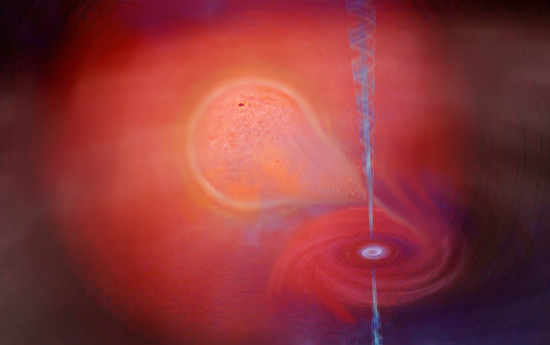BY LETTER
Multiple Systems
 Image from Steve Bowers | |
| Castor, a multiple system (image shows this system before stelllar engineering took place) | |
About 85% of all stars are in double or multiple systems. Some of the types are:
- Cataclysmic Variables - Comprising white dwarf primaries with M-type companions in semi-detached systems. Characterised by short periods. Accretion is often onto the white dwarf component.
- Algols - Algol systems comprise two 'normal' main sequence or subgiant stars in a semi-detached system.
- W Serpens Stars - These are active Algol systems. (see Algol)
- RS Canum Venaticorum Stars - Chromospherically active binaries of F and later spectral type components.
- BY Draconis Stars - Similar to RS Canum Venaticorum systems.
- W Ursae Majoris Contact Systems - Short period (0.2 to 0.8 day) contact binaries exhibiting very high levels of magnetic activity.
- X-Ray Binaries - Binaries with a neutron star or, more rarely, a black hole primary. Accretion onto the primary produces strong x-ray emissions.
- Zeta Aurigae Systems - Long period binaries comprising interacting type G or K supergiant and hot (type B) companion. Although not originally interacting systems, they become so when the more massive star evolves to become a supergiant.
- VV Cephei Systems - Similar to Zeta Aurigae binaries except a type M supergiant replaces the G or K type.
- Symbiotic Binaries - Long period (
- Barium and S-Star Binaries - Long period binaries in which the originally more massive component evolved into a white dwarf, transferring some of its nuclear-processed gas to a giant type K or M companion.
- Post-Common Envelope Binaries - Usually comprising a hot white dwarf or subdwarf, and a cooler secondary, which have passed through the common envelope phase. The binary nuclei of planetary nebulae are examples.
 Image from Steve Bowers | |
| An X-Ray binary system consisting of a red giant and a black hole | |
Celestia information | |
| To download Castor | The Castor system is available for download for the Celestia Space simulation program. The new model can be downloaded from this link: models and data copyright Phil Batchelor. |
|---|---|
| Please note | If you have the OA Universe add-on installed you will need to remove the file 'castor.ssc' from that add-on, as this new add-on supercedes it |
Related Articles
Appears in Topics
Development Notes
Text by Chris Clowes
Initially published on 08 December 2001.
updated 18 March 2009
Initially published on 08 December 2001.
updated 18 March 2009






